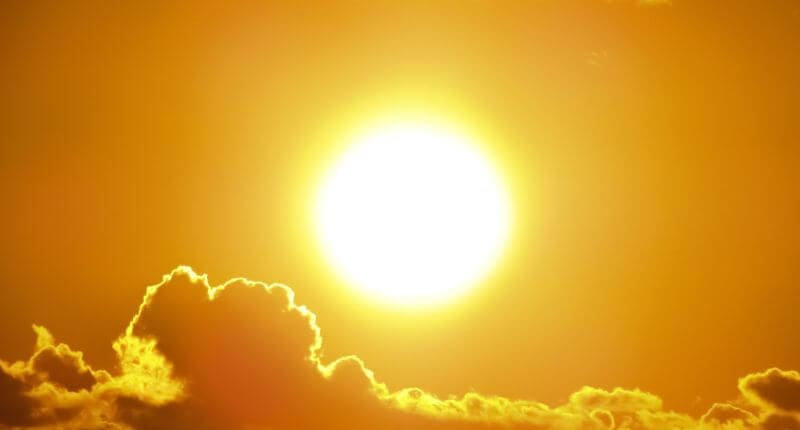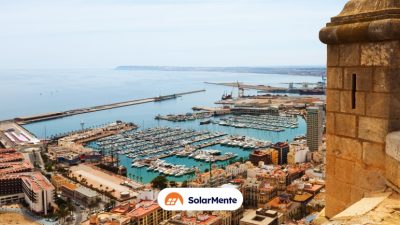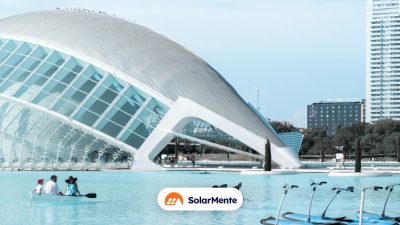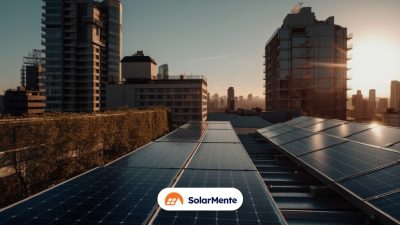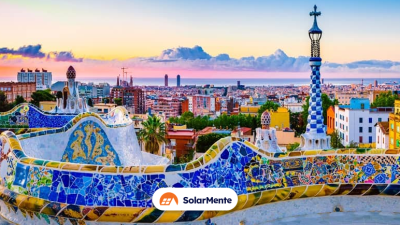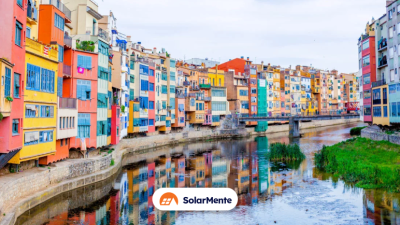At SolarMente, we want to help you better understand how the hours of sunshine and the Peak Solar Time (PST) in your province can make a big difference when it comes to installing solar panels.
Whether you are in the south with lots of sunshine or in a province with fewer solar hours, the important thing is to adapt the installation to your needs and location. Let’s discover together how to get the most out of solar energy!
What are Solar Hours and Peak Solar Time (PST)?
Solar hours are the effective time during which a surface receives direct radiation from the Sun.
It is not simply the amount of time that there is daylight, but the number of hours that the sun shines directly on a surface. This value is key to estimating the energy potential of a solar installation at a given location.
Solar hours are measured using heliographs, instruments that record the duration and intensity of the sun’s rays. The information obtained is known as insolation, and is an essential reference for calculating the energy that can be generated in a photovoltaic installation.
Definition of Peak Solar Time (PST)
The Peak Solar Hour (PSA) is a unit that measures the amount of solar energy received per square metre in one hour, with a standard irradiation of 1,000 W/m². This value is essential for the correct dimensioning of a PV installation, as it indicates how many hours per day solar radiation can be expected to be intense enough to generate electricity efficiently.
For example, an HSP of 5 in a province means that for 5 hours per day, solar radiation will be sufficient to generate approximately 5 kWh/m². This value varies according to season and geographical location, and has a direct impact on the performance of solar installations.
Importance of HSP for Photovoltaic Installations
The HSP is used to determine the solar power generation capacity of an installation. The higher the HSP, the more efficient the electricity production of a PV installation. This allows the size of solar panel systems, the type of inverter and other components to be adjusted according to the needs of each project.
HSP is especially relevant in areas with variable climates, where effective sunshine hours can fluctuate significantly throughout the year. Provinces with higher HSP, such as those in the south of Spain, make it possible to make the most of solar energy and reduce the payback time of the investment in the installations.
Factors Affecting Sunshine Hours and HSP in Spain
Geographical factors:
Spain is a country with great geographic and climatological diversity, which causes significant variations in the amount of sunshine hours received in the different provinces. The northernmost regions, such as Galicia and the Basque Country, tend to have fewer hours of sunshine than the southern regions, such as Andalusia and Murcia, due to factors such as altitude, the orientation of mountain ranges and proximity to the sea.
Provinces located at high altitudes or in mountainous areas may receive less direct solar radiation due to frequent cloud cover and orographic shading (when mountains block sunlight). On the other hand, coastal or flat regions, especially in the south, enjoy more hours of sunshine, which favours a higher photovoltaic potential.
Seasonal factors:
In addition to geographical differences, seasonal changes play a crucial role in solar hours. During summer, the days are longer and the sun is more inclined to the equator, which increases the duration and intensity of solar radiation. In contrast, in winter, the days are shorter and the sun is further away from the earth, reducing the effective solar hours.
The summer solstice, which occurs around 21 June, is the day of the year with the most daylight hours. From this date onwards, the hours of sunshine gradually decrease. The winter solstice, on 21 December, marks the day with the fewest daylight hours, after which sunshine hours slowly begin to increase. These seasonal changes must be considered when planning a PV installation, especially in regions where the differences between summer and winter are more pronounced.
Comparison of Solar Hours and HSP by Autonomous Communities on average, for Spain.

In this section, we will make a detailed comparison of the solar hours and Peak Solar Hours (PSA) by province in Spain. This information is key to understand the energy potential of each region and how it varies according to geographical location.
Here we would have the complete table with the differences between the different Spanish provinces:
| Province | Sun Hours | HSP | Autonomous Community |
| Almeria | 3305 | 6,02 | Andalusia |
| Cadiz | 3316 | 6 | |
| Cordoba | 3316 | 5,9 | |
| Grenada | 3228 | 5,93 | |
| Huelva | 3527 | 6,02 | |
| Jaén | 3289 | 5,82 | |
| Malaga | 3248 | 5,82 | |
| Seville | 3526 | 5,98 | |
| Huesca | 3099 | 5,67 | Aragon |
| Teruel | 3011 | 5,11 | |
| Zaragoza | 2620 | 5,61 | |
| Asturias | 1962 | 3,85 | Asturias |
| Cantabria | 1639 | 3,97 | Cantabria |
| Barcelona | 2453 | 5,4 | Catalonia |
| Girona | 2800 | 4,12 | |
| Lleida | 3031 | 5,59 | |
| Tarragona | 2820 | 5,47 | |
| Albacete | 3282 | 5,72 | Castilla la Mancha |
| Ciudad Real | 3295 | 5,76 | |
| Basin | 2779 | 5,57 | |
| Guadalajara | 2900 | 5,59 | |
| Toledo | 2815 | 5,78 | |
| Avila | 3065 | 5,27 | Castile-Leon |
| Burgos | 2751 | 4,98 | |
| Leon | 2734 | 5,31 | |
| Salamanca | 3262 | 5,34 | |
| Segovia | 3024 | 5,02 | |
| Soria | 2894 | 5,1 | |
| Valladolid | 3016 | 5,39 | |
| Zamora | 2858 | 5,43 | |
| Madrid | 2691 | 5,74 | Madrid |
| Alicante | 3397 | 5,73 | Valencian Community |
| Castellón | 3321 | 5,59 | |
| Valencia | 2808 | 5,73 | |
| Badajoz | 3224 | 5,74 | Extremadura |
| Cáceres | 3365 | 5,7 | |
| A Coruña | 2453 | 4,3 | Galicia |
| Lugo | 2820 | 4,3 | |
| Ourense | 2800 | 4,8 | |
| Pontevedra | 3031 | 4,4 | |
| Mallorca | 3098 | 5,3 | Balearic Islands |
| Menorca | 2981 | 5,3 | |
| Tenerife | 3098 | 5,3 | Canary Islands |
| Lanzarote | 2924 | 5,9 | |
| La Palma | 2800 | 5,9 | |
| La Rioja | 2708 | 4,54 | La Rioja |
| Murcia | 3348 | 5,7 | Murcia |
| Pamplona | 2285 | 5,74 | Navarre |
| Álava | 2147 | 4,2 | Basque Country |
| Guipúzcoa | 1906 | 3,6 | |
| Vizcaya | 1694 | 3,86 |
1. Provinces with the Highest Number of Solar Hours:
The southern provinces of Spain, especially in Andalusia, receive the most hours of sunshine per year. This abundance of sunshine makes them ideal areas for the installation of solar panels, with a high return on investment in a shorter period of time.
- Huelva: The sunniest province in Spain, with 3,527 solar hours per year and an HSP of 6.02. Thanks to these figures, solar installations in this region can generate energy consistently throughout the year.
- Seville: With 3,526 solar hours and an HSP of 5.98, Seville is another outstanding province. Its conditions are almost identical to those of Huelva, making both highly attractive for solar energy projects.
- Almeria: It receives 3,305 solar hours per year and has an HSP of 6.02, which places it among the most favourable provinces for photovoltaic energy generation.
2. Provinces with the Lowest Number of Solar Hours:
At the other extreme, the northern provinces of Spain, such as the Basque Country and Cantabria, receive the fewest solar hours.
Although these provinces have less solar radiation, photovoltaic installations are still viable thanks to government subsidies and support, which allow economic compensation to make the installations profitable.
- Biscay: With only 1,694 solar hours per year and an HSP of 3.86, it is the province with the fewest solar hours in Spain. This means that the energy yield of solar installations is more limited, although it is still possible to take advantage of solar radiation.
- Cantabria: It has 1,639 solar hours per year and an HSP of 3.97, which places it in a similar situation to Vizcaya. Although the hours of sunshine are limited, it is important to note that current technology allows solar installations to be viable even in areas with less sunshine.
- Guipúzcoa: This province has 1,906 solar hours and an HSP of 3.6, which also places it among the provinces with the lowest solar radiation, but with sufficient potential to generate photovoltaic energy.
3. Intermediate Cases:
Other provinces, especially in the central half of Spain, have intermediate conditions, with sufficient solar hours to make solar installations profitable, although without reaching the levels of the sunniest provinces in the south.
- Madrid: The capital city has 2,691 solar hours and an HSP of 5.74, which places it in an intermediate position. Despite being far from the solar hours of the south, the energy efficiency of solar installations in Madrid is considerable.
- Barcelona: With 2,453 solar hours and an HSP of 5.4, Barcelona has moderate but sufficient figures for efficient photovoltaic installations. The combination of solar hours and the use of advanced technologies makes it possible to make the most of the available solar radiation.
Frequently Asked Questions (FAQ)
1. What are solar hours and why are they important for a solar installation?
Solar hours are the number of effective hours in which a surface receives direct solar radiation. They are fundamental for a solar installation because they determine how much energy can be generated throughout the day in a specific location. Knowing the solar hours in your province allows you to correctly size the installation and maximise energy production.
2. What is the Peak Solar Time (PST) and how does it influence the efficiency of my installation?
The Peak Solar Hour (PSA) is a measure that indicates how much solar energy a surface receives during an hour of maximum solar radiation (at 1,000 W/m²). It is crucial because it helps you accurately calculate the generating capacity of your solar panels, which directly affects the efficiency of the installation. The higher the HSP, the more energy you can generate per square metre.
3. Is it profitable to install solar panels if I live in a province with few hours of sunshine?
Yes, it is possible that even in provinces with fewer hours of sunshine, such as Vizcaya or Cantabria, solar installations can be profitable. Although energy production may be lower compared to sunnier provinces, there are incentives, subsidies and storage batteries to optimise performance and save on electricity consumption in the long term.
4. Which are the provinces with the highest number of sunshine hours in Spain?
Among the sunniest provinces in Spain are Huelva, with 3,527 solar hours per year, Seville with 3,526 hours, and Cadiz with 3,316 hours per year. These provinces in the south of the country have great potential for solar energy generation, making them ideal areas for photovoltaic installations.
5. What impact do the seasons have on sunshine hours?
The seasons of the year have a great impact on solar hours. In summer, days are longer and solar radiation is more intense, which increases solar hours and energy production. In winter, on the other hand, the days are shorter, which reduces solar hours. However, with a good dimensioning of the installation, a good production can be ensured all year round.
6. How do I know how many solar hours my province has and how does this affect the installation?
You can consult solar hours and HSP tables to find out how many hours of sunshine your province receives. For example, in Madrid there are 2,691 solar hours per year, which means that an installation can be designed to fit these conditions and still be efficient. At SolarMente we help you evaluate this data and optimise your system.
7. Is it better to have more sunshine hours or a high HSP?
Both factors are important, but they are not always related. A province may have many solar hours but a lower HSP. Ideally, there should be a balance between the two to maximise energy production. However, in general, solar hours allow for more energy to be generated throughout the day, whereas
Before taking the step towards a photovoltaic installation, it is key that you have a good understanding of the specific characteristics of your province. Understanding the hours of sunshine and the Peak Solar Time (PST) in your area will help you to size your solar system correctly and get the most out of it.
At SolarMente, we are here to accompany you throughout this process. Together, we can design a tailor-made plan, designed for you to save as much as possible from day one and achieve a smart and profitable investment in the long term. Count on us to make your home more sustainable!

